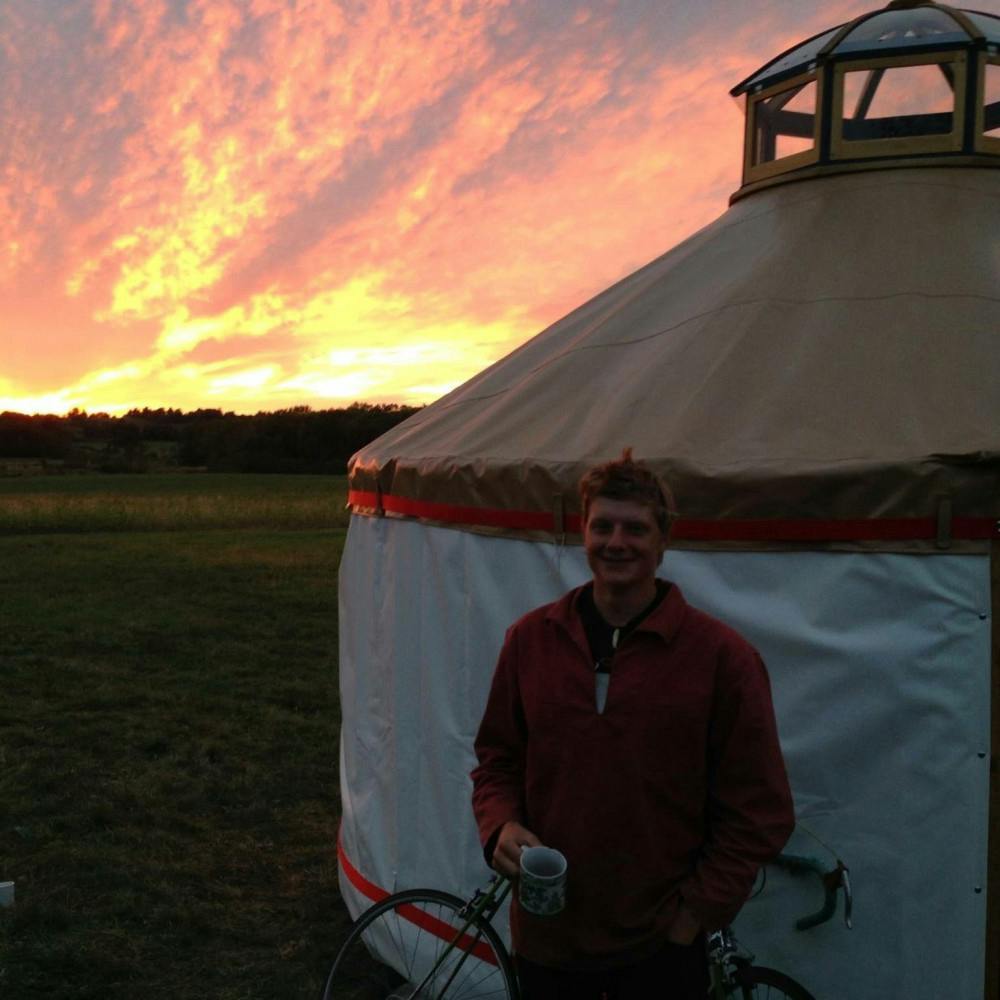If you have been out to the Organic Farm this semester, you may have noticed a fourteen-foot-wide circular tent-like structure nestled quaintly in the verdant rolling fields. Inside this wooden lattice frame draped with pale fabric, a west-facing window and cupola provides a breathtaking view of the sunset’s pinks and oranges bleeding into each other like watercolors on canvas.
This new addition to the campus is one student’s take on the highly portable yurt used as shelter by Central Asian nomads as they migrate from one grazing area to another herding sheep and horses. The yurt is the brainchild and craftsmanship of Geology major Milo Stanley ’17.5.
When asked why he built the yurt, Stanley simply chuckled and said he really wanted one.
“I’ve always been fascinated with small spaces,” he said. “I built forts when I was a kid, [and] treehouses. [Yurts] are really incredibly beautiful. It’s a really intelligent design.”
Stanley uses the yurt as his own personal space, door lock included. He tries to visit every day, preferably in the late afternoon after class for some brief moments of privacy.
“I use it for getting away from the stress of college life,” he said. “It’s nice to be able to get out there and study or relax.” he said.
Stanley also enjoys inviting friends and socializing in the yurt.
“We come out for a picnic lunch or cup of tea,” he said. “It’s a nice place to be able to spend time with friends.”
The yurt’s shape also facilitates social gathering, he explained, since no one can sit alone in a corner.
Stanley’s inspiration was Bill Coperthwaite, the American pioneer of yurt building. As a college student at Harvard, Coperthwaite constructed one on campus after seeing it in National Geographic. He designed nontraditional wooden yurts with walls and roofs made completely from wood, and traveled around the country to teach others how to build them. He lived in a concentric yurt, a multi-story structure made of yurts stacked on top of one another like the layers of a wedding cake.
When Stanley was eleven or twelve, he read Coperthwaite’s The Handmade Life, wrote him a letter, and visited Coperthwaite’s yurt complex in Maine.
“I spent a day with him and got to know him, and didn’t think much about building yurts back then,” he said. “More recently, I’ve really been into the idea, and had the opportunity this summer to work on it and complete projects. I jumped at that. Now I have a yurt. It’s fantastic.”
Stanley conceived the idea of building his own yurt last fall and realized it this summer in Maine, devoting all his free time after his full-time job and on weekends to construction. He brought it back to Middlebury this term and identified the Organic Farm as an ideal on-campus location for it because of the farm’s remoteness and beauty. Because of its extraordinary transportability, Stanley erected it in just two or three hours, and plans to pack it up and carry it with him when he leaves campus next summer.
“All the individual pieces are very small, but it’s an incredibly strong structure,” said Stanley.
The yurt consists of a framework of slender wooden lattice sticks that can be expanded to form the walls. A wire rope contains and brings the outward force from the rafters down to the ground. The outside and roof of the yurt is composed of a rubberized polyester membrane called Duro-Last, while the walls are made of vinyl and a lighter thin foil-backed foam for insulation. The interior, decorated by a few cushions and a couple of small shelves, is minimalist.
Time was both Stanley’s greatest foe and friend in completing this project.
“Many days, I just did not feel like going right back to work and cranking on it for another couple of hours, but I really had to, just to finish it in time to bring it back to college,” he said. “I’ve never been that motivated on a project before. I’m proud that I managed to pull it off.”
This was Stanley’s first, and will probably be the last yurt he builds.
“This one’s going to last me a long time and I’m very happy with it,” he said. “I’d never built something like that [the yurt] before. I really enjoyed that challenge, thinking my way through it and getting out into the shop and building it, far more than any academic challenge.”
Even so, Stanley has incorporated his yurt-building experience into an academic opportunity through a creative writing project about the process of building a yurt and its current use.
“There are a lot of stories that have come out of the whole project and it’s nice to have an academic excuse to write them down,” he said.
Private Yurt Erected on Organic Farm

Comments


